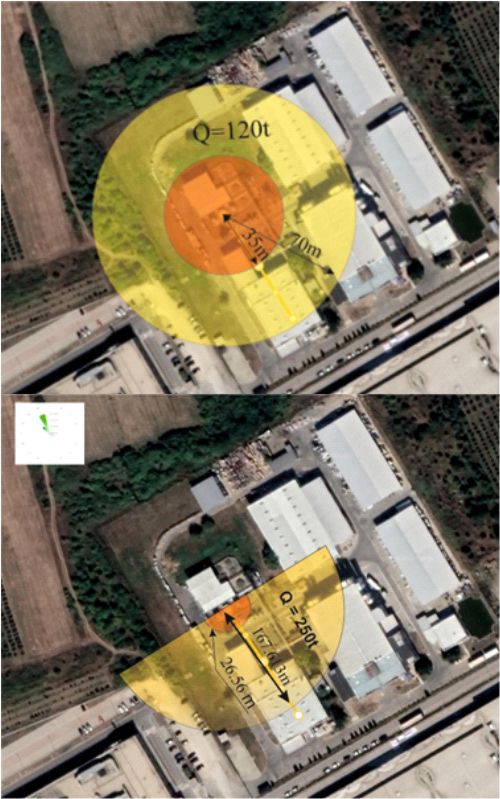Atmospheric release of organic solvents due to hazardous events in the paints and varnishes industry Technical paper
Main Article Content
Abstract
Technogenic risk is the result of creation and development of hazards that originate from accidents in the technosphere. It involves emissions of hazardous industrial substances into the work and natural environments, fires, radioactive contamination, and contamination by toxic substances during their transport and storage. The qualitative and quantitative technogenic risk assessment has to be performed during the use, handling, transport, and storage of hazardous substances if it is decided that specific environmental elements at a specific location are likely to become exposed to hazardous substances, leading to environmental degradation. This paper discusses vulnerability zones – specifically, the high lethality zone and the irreversible effects zone – that are formed due to hazardous events or accidents in the paints and varnishes industry. Accidents are discussed in terms of exposure to solvents classified as hazardous to ecosystem components, the biosphere, anthroposphere, and the human population during their atmospheric dispersion. The vulnerability zones are designated using the REHRA (Rapid Environmental and Health Risk Assessment) methodology and their spatial arrangement is used to perform the risk assessment for the purpose of notifying authorized institutions and the public about a potentially increased risk at the hazard location and/or the immediate vicinity.
Article Details
Issue
Section

This work is licensed under a Creative Commons Attribution-NonCommercial-NoDerivatives 4.0 International License.
Authors who publish with this journal agree to the following terms:
Authors retain copyright and grant the journal right of first publication with the work simultaneously licensed under a Creative Commons Attribution License that allows others to share the work with an acknowledgement of the work's authorship and initial publication in this journal.
Authors grant to the Publisher the following rights to the manuscript, including any supplemental material, and any parts, extracts or elements thereof:
- the right to reproduce and distribute the Manuscript in printed form, including print-on-demand;
- the right to produce prepublications, reprints, and special editions of the Manuscript;
- the right to translate the Manuscript into other languages;
- the right to reproduce the Manuscript using photomechanical or similar means including, but not limited to photocopy, and the right to distribute these reproductions;
- the right to reproduce and distribute the Manuscript electronically or optically on any and all data carriers or storage media – especially in machine readable/digitalized form on data carriers such as hard drive, CD-Rom, DVD, Blu-ray Disc (BD), Mini-Disk, data tape – and the right to reproduce and distribute the Article via these data carriers;
- the right to store the Manuscript in databases, including online databases, and the right of transmission of the Manuscript in all technical systems and modes;
- the right to make the Manuscript available to the public or to closed user groups on individual demand, for use on monitors or other readers (including e-books), and in printable form for the user, either via the internet, other online services, or via internal or external networks.
How to Cite
Funding data
-
Ministarstvo Prosvete, Nauke i Tehnološkog Razvoja
Grant numbers 451-03-68/2022-14/200148
References
Carter RE. Organic solvents: properties, toxicity, and industrial effects. New York: Nova Science Publishers; 2011 ISBN: 978-1617618819.
The U.S. Chemical Safety Board. https://www.csb.gov/lyondellbasell-fatal-chemical-release-/?msclkid. accessed 15. August 2022.
Chemical and engineering news. https://cen.acs.org/articles/94/web/2016/04/Chemical-accident. accessed 15. August 2022.
Hazardex. https://www.hazardexonthenet.net/article/111211/Casualties-reported-in-Taiwan-chemical-plant-blast.aspx. accessed 15. August 2022.
The BARPI (Bureau for Analysis of Industrial Risks and Pollutions). https://www.aria.developpement-durable.gouv.fr/fiche_detaillee/47045_en/?lang=en. accessed 15. August 2022.
China Dialogue. https://chinadialogue.net/en/pollution/8142-timeline-china-s-chemical-disasters/. accessed 25. August 2022.
Portal-Srbija. https://www.portal-srbija.com/proizvodnja-veleprodaja-boja-i-lakova. accessed 25. August 2022.
Republički zavod za statistiku, Republika Srbija. https://www.stat.gov.rs/media/5918/industrijska proizvodnja po proizvodima. accessed 25. August 2022.
b92.net. https://www.b92.net/info/vesti/index.php. accessed 25. August 2022.
Mondo. https://mondo.rs/Info/Drustvo/a67909/Ugasen-pozar-u-fabrici-Nijansa-kod-Nisa.html. accessed 27. August 2022.
Južne Vesti. https://www.juznevesti.com/Hronika/Pirot-lokalizovan-pozar-u-fabrici-Suko.sr.html. accessed 27. August 2022.
Srbija Danas. https://www.srbijadanas.com/vesti/hronika/povreden-radnik-u-pozaru-u-fabrici-kod-uzica-nakon-eksplozije-zadobio-teske-opekotine-opasne-po-2019-08-16. accessed 27. August 2022.
Politika. https://www.politika.rs/sr/clanak/461621/Ugasen-pozar-u-magacinu-fabrike-Goeks-kod-Nisa. accessed 27. August 2022.
The Industrial Emissions Directive 2010/75/EU. http://ec.europa.eu/environment/industry/stationary/ied/legislation.htm. accessed 27. August 2022.
Putanov P. Rastvarači. Beograd:Tehnička knjiga; 1980. (na srpskom)
Rapid Environment and Health Risk Assessment, REHRA 2. Italian Ministry for the environment and territory - Department for Global Environment; 2003.
Đorđević A, Stevanović V. Ekološki rizik. Niš: Fakultet zaštite na radu u Nišu, Univerzitet u Nišu; 2020 ISBN 978-86-6093-091-2. (na srpskom)
Classification, Labelling and Packaging of Substances and Mixtures Regulation 1272/2008 of the European Parliament and of the Council. http://ec.europa.eu/environment/chemicals/labelling/index_en.htm. accessed 25. September 2022.
UN Globally Harmonized System of Classification and Labelling of Chemicals (GHS). United Nations; 2015 https://doi.org/10.18356/591dabf9-en.
Smallwood I. Handbook of Organic Solvent Properties. New York: John Wiley and Sons; 1996 ISBN: 9780080523781.
NIOSH Chemical Listing and Documentation of Revised IDLH Values (as of 3/1/95). http://www.cdc.gov/niosh/idlh/intridl4.html. accessed 25. September 2022.
Ludwig RH, Cairelli SG, Whalen JJ. Documentation for Immediately Dangerous to Life or Health Concentrations (IDLHs). Ohio:U.S. Department of Health and Human Services, Public Health Service, Centers for Disease Control and Prevention, National Institute for Occupational Safety and Health, Division of Standards Development and Technology Transfer Cincinnati; 1994 https://www.cdc.gov/niosh/idlh/pdfs/1994-IDLH-ValuesBackgroundDocs.pdf.





